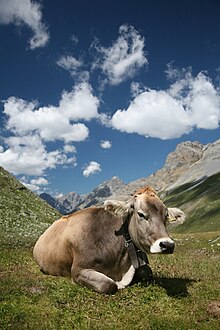Bos
| Bos | |
|---|---|

| |
| Cattle (Bos taurus) | |
| Scientific classification | |
| Domain: | Eukaryota |
| Kingdom: | Animalia |
| Phylum: | Chordata |
| Class: | Mammalia |
| Order: | Artiodactyla |
| Family: | Bovidae |
| Subfamily: | Bovinae |
| Tribe: | Bovini |
| Genus: | Bos Linnaeus, 1758 |
| Type species | |
| Species | |
|
See § Species. | |
Bos (from
cattle.Bos is often divided into four
Description
The species are grazers, with large teeth to break up the plant material they ingest. They are ruminants, having a four-chambered stomach that allows them to break down plant material.[6]
Distribution
There are about 1.3 billion domestic cattle alive today, making them one of the world's most numerous mammals. Members of this genus are currently found in Africa, Asia, Europe, parts of North America, South America and also in Oceania. Their habitats vary greatly depending on the particular species; they can be found in prairies, rain forests, wetlands, savannah and temperate forests.
Ecology
Most Bos species have a lifespan of 18–25 years in the wild, with up to 36 being recorded in captivity. They have a 9–11 month gestation, depending on the species and birth one or, rarely, two young in the spring.[citation needed]
Most species travel in small herds ranging in size from ten to thirty members. Within most herds, there is one
They are generally
Taxonomy
In 2003, the International Commission on Zoological Nomenclature resolved a long-standing dispute about the naming of those species (or pairs of species) of Bos that contain both wild and domesticated forms. The commission "conserved the usage of 17 specific names based on wild species, which are pre-dated by or contemporary with those based on domestic forms", confirming Bos primigenius for the aurochs and Bos gaurus for the gaur. If domesticated cattle and gayal are considered separate species, they are to be named Bos taurus and Bos frontalis; however, if they are considered part of the same species as their wild relatives, the common species are to be named Bos primigenius and Bos gaurus.[8]
During the 2010s, analysis of the complex genetics of the bovine lineages determined that the genus Bison needed to be relegated to a subgenus of Bos in order to retain monophyly within Bos since both extant species of Bison are phylogenetically embedded within Bos.[5] The specific relationships in these analyses determined that the two living bison species were each other's closest living relatives, with their closest relatives amongst Bos being the yaks based on nuclear DNA. The mitochondrial DNA for the wisent was found to contradict the nuclear DNA result, and was more closely related to those of cattle, while the mitochondrial DNA of the American bison supported the nuclear DNA result of a close relationship with yaks. The discrepancy between the mitochondrial DNA of the American bison and wisent is suggested to be likely due to incomplete lineage sorting or genetic introgression into B. bonasus from other Bos species.[5][9][10]
Relationships of members of the genus Bos based on nuclear genomes after Sinding, et al. 2021.[11]
| Bos |
| |||||||||||||||||||||||||||||||||
Species
The following species are known:[2][12]
- Subgenus Bos Linnaeus, 1758
- Bos taurus(domestic cattle)
- B. t. taurus(Taurine cattle)
- B. t. africanus(Sanga cattle)
- Bos (taurus) indicus(zebu or indicine cattle)
- †Bos primigenius(aurochs)
- †B. p. primigenius(Eurasian aurochs)
- †B. p. mauritanicus(North African aurochs)
- †B. p. namadicus(Indian aurochs)
- †
- †Bos acutifrons
- †Bos buiaensis
- Subgenus Bibos Hodgson, 1837
- Bos gaurus(gaur or Indian bison)
- Bos frontalis(gayal)
- Bos javanicus(banteng)
- B. j. domesticus (Bali cattle)
- †Bos palaesondaicus
- †Bos sauveli(kouprey) (likely extinct, last seen 1969)
- Subgenus Poephagus Gray, 1843
- Bos mutus(wild yak)
- Bos grunniens(domestic yak)
- †Bos baikalensis
- Subgenus Bison Hamilton Smith, 1827[5] (traditionally treated as a separate genus)
- Bos bison (American bison)[13]
- B. b. bison (plains bison)
- B. b. athabascae (wood bison)
- Bos bonasus (wisent or European bison)[14]
- B. b. bonasus (lowland wisent)
- †B. b. hungarorum(Carpathian wisent)
- †B. b. caucasicus(dombay or Caucasian wisent)
- †Bos priscus (Steppe wisent)
- †Bos antiquus
- †Bos hanaizumiensis
- †Bos latifrons
- †Bos menneri[15]
- †Bos occidentalis
- †Bos schoetensacki
- †Bos palaeosinensis
- †Bos sivalensis
- †Bos georgicus[15]
- Bos bison (American bison)[13]
See also
References
- Smithsonian Miscellaneous Collections. 73 (1): 35–37.
- ^ ISBN 9780801882210.
- ^ Groves, C. P., 1981. Systematic relationships in the Bovini (Artiodactyla, Bovidae). Zeitschrift für Zoologische Systematik und Evolutionsforschung, 4:264-278., quoted in Don E. Wilson & DeeAnn M. Reeder (editors). 2005. Mammal Species of the World. A Taxonomic and Geographic Reference (3rd ed), Johns Hopkins University Press: "Bison". (online edition )
- Baltimore, Maryland.
- ^ a b c d Wang, K., Lenstra, J. A., Liu, L., Hu, Q., Ma, T., Qiu, Q., & Liu, J. (2018). Incomplete lineage sorting rather than hybridization explains the inconsistent phylogeny of the wisent. Communications biology, 1(1), 1-9.
- ^ ISBN 906754678X. rapport 186. Retrieved 4 January 2020.
- Macmillan Publishing
- ^ International Commission on Zoological Nomenclature (2003). "Opinion 2027 (Case 3010). Usage of 17 specific names based on wild species which are pre-dated by or contemporary with those based on domestic animals (Lepidoptera, Osteichthyes, Mammalia): conserved". The Bulletin of Zoological Nomenclature. 60 (1): 81–84.
- PMID 34712923.
- .
- PMID 34712923.
- . Retrieved 3 January 2020.
- ^ "Bos bison Linnaeus, 1758".
- ^ "Bos bonasus Linnaeus, 1758".
- ^ a b Biolib.cz, Genus - Bisons
External links
- Vasey, George 1862. A monograph of the genus Bos. Scan of a historic work
